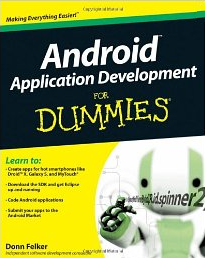Android Application Development for Dummies Book Review
Update: This review was for the first edition of the book. That is now well out of date so look at reviews for later editions, now called Android App Development For Dummies.
When it comes to designing an IT solution based on the Android operating system you have three choices, outsourcing, hiring in contractors, or in-house development. Doing in house development is good for businesses that have existing dedicated teams to maintain in house software projects. However, Android programming is not yet a widespread skill so in house teams need bringing up to speed quickly. A good overview book of programming for Android would help. Let us see if Android Application Development for Dummies does the job.

This is a good if flawed book. If you are new to programming you will have a hard time getting through this book without any additional help. An experienced programmer will find it a comprehensive introduction, but have the occasional frustrating time with the example code. Being called a "Dummies" book suggests it'll take you from the ground up, in regards to Android this is true, in regards to Application Development a certain level of knowledge is assumed and there is no mention on the book's cover of the need to know Java and XML, those requirements are mentioned in the fifth paragraph of the intro. Therefore total beginners will need to wade through a Java and XML book before tackling this one. Yet the text is a contradiction at points, it assumes you know Java but holds your hand in showing you how to get hold of the Java SDK, surely a Java programmer would know about the SDK already. It's a "Dummies" book yet none of the Android SDK helper screens are discussed or used, all the XML is hand typed (or copied over from the downloaded source code). It is a similar issue with the programming environment. The Eclipse IDE is powerful and flexible, but first time Eclipse users will feel lost until you they used to it. An Appendix giving a quick overview of Eclipse would have helped greatly.
Whilst the book blurb does not mention the need for previous programming experience it does mention on the rear "cool ways to use the accelerometer in your app", but there is no code in the book to do that, merely a link to an open source program.
It's not until page 76 that the ubiquitous "hello, world" program is running. So that's 76 pages before you are running anything. Having said that the programs that follow do give you a good grounding in the aspects of Android that are needed to develop a full featured App and publish it to the Marketplace. The main example application that is developed in the book does get bogged down occasionally with pages of code to type out (or copy across) but not much to show for it. If you type code in from the book to aid learning you need to be careful as it is easy to miss something and sit scratching your head trying to comprehend the error messages in Eclipse. Although going back over the text and code eventually finds the issue. Beginners could slip up when following the text as some things are assumed based on previous chapters, e.g. adding the import statement for external classes.
There are a handful of errors in the book, some not the responsibility of the author because although this is a relativley new book the Android SDK has already been revised and as a result some of the screen shots in the book are out of date. However, the author has an active blog and has published updates to his book there, there is also a contacts page if you need to send a question.
In summary a good book if you're prepared to put in the work but room for improvement if they produce a future second edition.
Author:Daniel S. Fowler Published: Updated:







